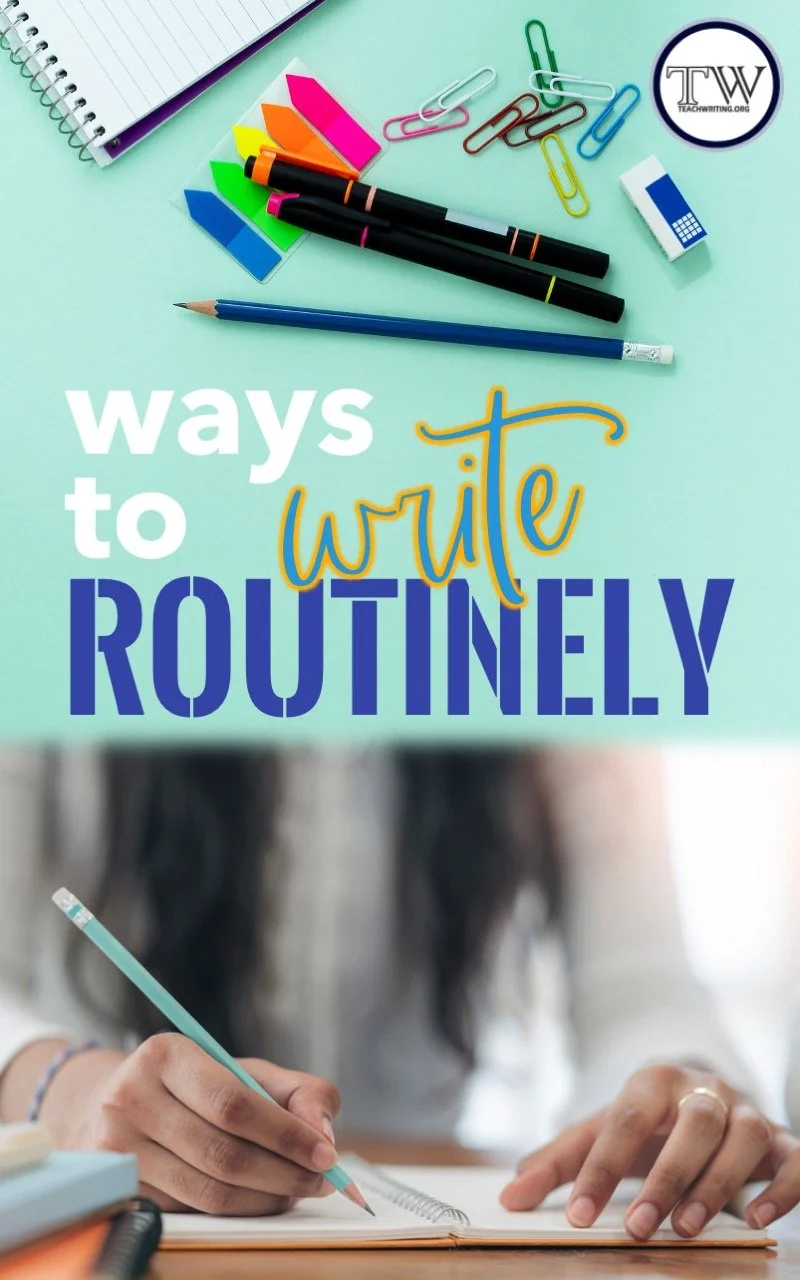4 Ways to Help Students Write Routinely
“But I hate writing!” How many times have you heard students express their utter distaste for writing? Invariably, as I’ve dug deeper into pushback with writing, students express they aren’t good at it…it feels like work…it’s not fun…or it overwhelms them.
One of the best ways we can help students grow as writers is to help them develop a taste for it. Unfortunately, that doesn’t happen through five paragraph essays. To be clear, I’m not opposed to a structured essay. They have value, and I love working through at least one lengthy literary analysis, argumentative, and informative piece each year. But. That’s not what we are talking about here. In order to help students grow as writers, they need to be writing routinely, building their writing stamina through volume over time. Whenever possible, they need to be given some flexibility in approach and topic and enjoying the process!
Kelly Gallagher, a high school ELA teacher, author, and consultant, claims students should write four times the amount of writing than a teacher can actually grade. If that elicits a wave of anxiety, breathe! We cannot and should not grade every piece of writing a student completes. As Gallagher and Atwell can attest, the act of putting a final grade on an assignment actually ends the learning process.
Instead of marking up that large stack of physical or virtual papers, why not have students set some goals for their writing in relation to standards? We can confer with them, giving them meaningful, real-time feedback they can apply throughout the writing process. When they begin to see their own growth in areas they choose to focus on, it will motivate them to continue writing…and enjoy it.
One of the Common Core writing standards indicates students need to “Write routinely over extended time frames (time for research, reflection, and revision) and shorter time frames (a single sitting or a day or two) for a range of discipline-specific tasks, purposes, and audiences.” And, this goal applies to all content areas…not just ELA. This standard is intended to remind us that we need to build in frequent opportunities for students to practice writing, to play with language, and to find their voices.
Increased writing volume results in writing growth just as increased reading volume results in growth as readers. So, what are some practical ways we can build in time for routine writing?
BELL RINGERS
I love using vocabulary bell ringers. Students learn a new word each day, and they practice using the word in writing with guidance. As time progresses, we spiral in practice with previous words students understand well by incorporating them into creative writing assignments.
Bell ringers are a convenient opportunity for us to build in a variety of routine writing experiences. Teacher authors at Teachwriting.org have crafted 100 free bell ringers for subscribers that cover mentor sentences, narrative, creative, argumentative, and informative writing. Download them here.
WRITING PROCESS
Students need to learn the value of the writing process. Much of the work students do in writing happens in the thinking and decision making process. This mental taxation is often what causes students to dislike writing. They have so many thoughts swirling in their heads, but how do they sort them out?
We can help students learn to take the driver’s seat in their writing when we embed the writing process in everything we do. At the beginning of the year, I like to introduce the writing process both with a kinesthetic activity and a minimal, sentence-level approach.
Throughout the year, we continue emphasizing the writing process with every piece of writing. Allowing students time to sit in their writing, reflect on it, rearrange it, and grow with it makes writing an enjoyable routine rather than a checkbox to turn in and never think of again.
AUTHOR’S CRAFT
Share reading with students often. Strategically choose texts to model skills and strategies. Picture books, first pages, high-interest excerpts, examples of creative author’s craft. Talk about the choices an author makes stylistically and how those impact readers.
sentence structure
mid-action entry points
playful dialogue
crafty language and word choice
beautiful description
After studying examples, give students time to play! In the Fall, teachers are often diving into short stories with students. Short stories lend themselves well to literary analysis, which opens the door for narrative writing. Give students some spooky story starters and ask them to play with language like an author has in a work you have just shared together. Or, study how authors use description to bring characters to life, and then ask students to create their own examples of showing, not telling!
RESPONse to LITERATURE
Start with the basic, and move into more complex response types. Students can start by summarizing what they have read. Nonfiction summarizing, for example, can be a powerful writing task for students to maximize comprehension.
Students can write in notebooks or journals. These responses can also be informal and simplified to a sticky-note for reading sprints. Routine writing can be prompted specifically by skill questions that lead students to…
make predictions
explain viable connections
visualize the scene
evaluate an author’s technique
empathize with perspective/point of view
analyze to explain the theme or main idea
Or, responding to literature can be as simple as…Respond to what you just read. What are you thinking? This type of response can easily become a writing routine if we build it into reader’s or writer’s workshop.
Pretty much any time we are reading, we can offer students the opportunity to write routinely about what they’ve read. When students are learning new words or language skills, we can teach them to enjoy using those elements in their writing. Reading and writing are reciprocal. When students grow in one, they grow in the other. And, when we teach them to enjoy pairing the two together, they’ll truly go places as young authors.
ABOUT THE AUTHOR
Melissa is the author of Reading and Writing Haven and a collaborative blogger on Teachwriting.org.
A middle and high school English teacher for over a decade now turned instructional coach, Melissa is an avid reader and writer, and she loves sharing ideas and collaborating with fellow educators. Melissa use her degrees in English, Curriculum & Instruction, and Reading as well as her Reading Specialist certification to ponder today’s educational issues while developing resources to help teachers, students, and parents make learning more relevant, meaningful, and engaging.
Visit Melissa on Instagram, Facebook, or Twitter for English teacher camaraderie and practical, engaging teaching ideas.
Writing routinely is important to student growth and attitudes toward writing.







